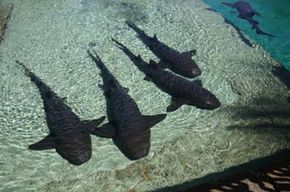Nurse Shark Habitat and Reproduction
The nurse shark lives in warm waters in the Atlantic and eastern Pacific oceans [sources: Guarracino, National Geographic]. It's often seen in Florida, especially around the Keys. They've been spotted as far north as Rhode Island (though this is uncommon) and all the way down to Brazil. On the west coast of North and South America, they are found from Mexico to Peru. They're also abundant in the Caribbean and the Gulf of Mexico, and along the eastern Atlantic coast of Africa [source: Busch Gardens].
But you may not need to go far to spot a nurse shark; they're commonly found in aquariums because they're very easy to care for. A director at a marine laboratory commented on their hardiness by saying that you could almost roll them up in wet newspaper, and they'd be okay [source: Stevens].
Advertisement
If you were to see them in their natural habitat, there'd be very little going on. Nurse sharks are nocturnal hunters and rest during the day. They usually dwell at the foot of the ocean floor, hovering above the sandy bottom. Groups of nurse sharks are also known to seek out reefs or caves, and these groups have been observed to be almost lying on top of each other [source: Castro]. Though they go out at night to hunt, nurse sharks are creatures of habit. They return to certain resting sites, and they rarely migrate.
But staying in one place can have repercussions when it comes to mating, and some scientists have wondered how the nurse shark has avoided the dangers of inbreeding. It turns out that one way nurse sharks encourage genetic diversity is by having more than one male fertilize a litter. In 2002, a study showed that the DNA of 32 pups born to one mother yielded at least four possible fathers [source: Saville et al.].
When male nurse sharks want to mate, they bite the female on her pectoral fin to hold her into position. Scientists have observed female sharks avoiding males by swimming to shallow water and burying their pectoral fin in the sand [source: Castro].
The nurse shark is ovoviviparous, which means that the female shark carries the fertilized eggs in egg cases within her ovaries. The embryos receive nourishment from the yolk in the egg cases, and once that's finished, the shark pups hatch from the egg case and are soon born. The gestation period for nurse sharks is about six months [source: Castro]. Nurse shark pups start life at about a foot long [source: Guarracino]. Once a female has produced a litter, it takes her 18 months to produce more eggs [source: Guarracino].
Nurse shark pups are nourished by a yolk sac, but what do adult nurse sharks eat? Find out on the next page.
